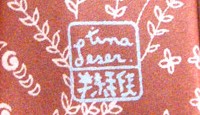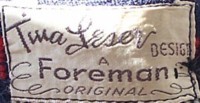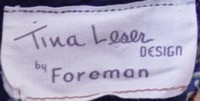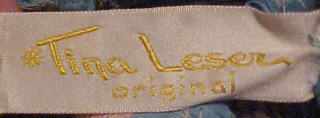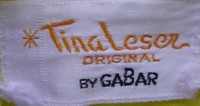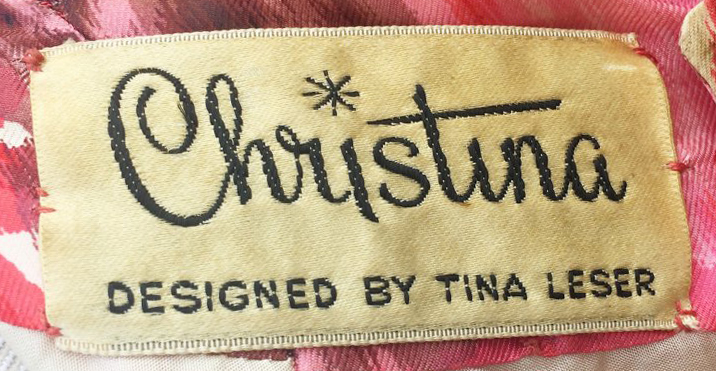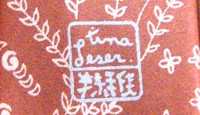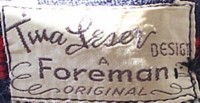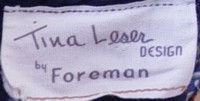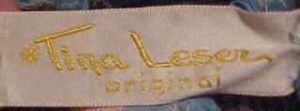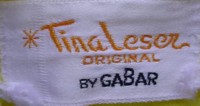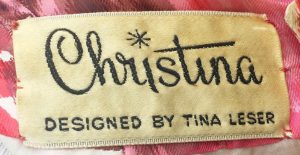Tina Leser (1910-1986) was born Christina Buffington (later adopted as Christina Wetherill Shillard-Smith) in 1910. She was born into an affluent Philadelphia family that traveled the world. Leser first attended the Pennsylvania Academy of Fine Arts, and then the Sorbonne in Paris.
In 1931, at the age of 21, Tina married Curtin Leser, and the two of them moved to Honolulu, Hawaii. It was here that Tina Leser began her career in fashion. She opened a shop in 1935, in which she sold clothing that she designed. Leser used native Hawaiian and imported Filipino fabrics to construct sportswear, day wear and gowns. She then worked with a process to hand-block designs onto sailcloth. As an artist, she often hand painted a fabric to order. A customer might order a special garment with the family pet hand painted on it.
In 1940, Tina Leser went to New York on a buying trip and to try and sell her designs. Partly through the influence of Harper’s Bazaar editor, Carmel Snow, she placed an order with Saks for 500 garments. She continued to live and work in Honolulu, but in 1941, decided to open a business in New York. Due to WWII she closed her Honolulu store in 1942 and moved to New York. There she ran her company until the next year, when she became the designer at Edwin H. Foreman. It was at Foreman that Tina Leser developed the international style for which she became famous.
It was wartime, and travel around the world was quite limited for the private citizen. But Leser looked for, and found, interesting cultural influences close to home – Mexico, Guatemala, Hawaii, and the USA countryside. She utilized Hawaiian shapes – the sarong and the wrap skirt, and also used Hawaiian fabrics to make an innovative bathing suit that had just one strap. And she referenced the United States by taking the coveralls adopted by so many American women factory workers, and making attractive versions in flannel and plaid.
After the war, Tina continued to design clothing for the active woman. She also made more traditional evening wear. In the postwar era, India was very much in the news, and in Tina Leser’s mind. Having spent part of her childhood in the country, it was natural that India’s move toward independence would inspire her to base many of her designs on the country’s ethnic clothing. She began the first of many designs based on the fabrics, colors and shapes of Indian traditional clothing.
Leser was married in 1948 to James Howley (she and Leser had divorced in 1935), and for their honeymoon the pair took a trip around the world. Actually, it was an inspiration-finding expedition, and it led to her Fall 1949 multi-cultural collection. The influences were gathered from what she would see on every step of her journey.
After 1949, Leser continued to reference a variety of ethnic influences, often mixing them in a single garment or collection. For example, she might take a purely American fabric such as the red and white check commonly used in picnic tablecloths, and sew it into an item with an Oriental-influenced shape such as a sarong or kimono.
Tina Leser left Foreman in 1953 to form her own company, Tina Leser Originals. In the 1950s, women needed clothes for an increasingly casual lifestyle, and Leser’s pieces were casual but sophisticated. People were entertaining at home, and many of Leser’s ads during the 50s show a relaxed hostess curled up in a pair of her slacks and a comfortable tunic.
She perfected (some references say “invented”) the slim toreador pants of the 50s, which were often paired with exotic tunics or cashmere sweaters trimmed with embroidered edgings. And in 1957 she showed a cashmere sweater that was dress length, bringing about the inception of the “sweater dress.”
She entered into a design arrangement with Gabar Swimsuits, and she designed for them for many years. She’s often thought of as a swimsuit designer, mainly because her work for Gabar was so wide-reaching. But it was not just swimsuits she was designing – it was a whole new way of wearing it. The cover-ups and skirts and matching shorts and wraps incorporated the design of the swimsuit beneath into a complete ensemble. The bathing suit became the foundation for streetwear.
In 1964, Leser closed her business, only to open it again in 1966. Her first collection after her re-opening was a tribute to India, with the fabrics being made on traditional Indian looms. She continued to make clothing that was oriental in feel, but she concentrated less on sportswear and more on clothing which was adaptable to many situations, be it evening, day or at-home. Her fabrics were still very much inspired by her travels. Tina Leser Originals remained open until 1982. Leser died four years later in 1986.
Written by fuzzylizzie
